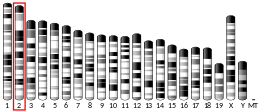Alpha-1D adrenergic receptor
Protein-coding gene in humans From Wikipedia, the free encyclopedia
The alpha-1D adrenergic receptor (α1D adrenoreceptor), also known as ADRA1D, is an alpha-1 adrenergic receptor, and also denotes the human gene encoding it.[5]
Receptor
There are 3 alpha-1 adrenergic receptor subtypes: alpha-1A, -1B and -1D, all of which signal through the Gq/11 family of G-proteins and different subtypes show different patterns of activation. They activate mitogenic responses and regulate growth and proliferation of many cells.
Gene
This gene encodes alpha-1D-adrenergic receptor. Similar to alpha-1B-adrenergic receptor gene, this gene comprises 2 exons and a single intron that interrupts the coding region.[5]
Ligands
Many α1 receptor ligands are non-selective for receptor subtypes.
- Antagonists
- A-315456[6]
- BMY 7378 (also α2C antagonist)[7]
- Domesticine[8]
- Cyclazosin (slight α1C selectivity)[9]
- Tamsulosin (roughly equal affinity for α1A)[9]
See also
References
Further reading
External links
Wikiwand - on
Seamless Wikipedia browsing. On steroids.






